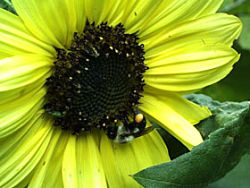
Just about all gardeners are aware that honeybees are in trouble and that scientists are hard at work trying to figure out the cause of their mysterious decline, called colony collapse disorder. And native bumblebees are in distress as well.
Now some new research indicates that some widely used pesticides may be playing an important role in the bees' demise. The nicotine-related neonicotinoids are systemic pesticides that become incorporated into a treated plant's tissues. This makes them effective against a number of chewing and sucking pests, but also means that the chemicals work their way into the pollen and nectar that the bees collect and bring back to their hives.
In one study, bumblebees were exposed to the levels of pesticide they would encounter if they were visiting a field of canola flowers that had been treated with a neonicontinoid -- low enough not to kill the bees outright. After two weeks of the eating pesticide-spiked pollen and sugar water, the bees were let out to forage naturally. By the end of the season the exposed colonies were significantly smaller than unexposed ones due to a decrease in the production of new young queens. Since the queens are the only members of a bumblebee colony to survive the winter, this drop in reproduction has dire consequences for the future of the bees.
In another study, researchers (amazingly) attached electronic identifiers to 600 individual bees with dental cement. They fed the bees non-lethal doses of pesticide-laced sugar water, then took the bees a kilometer from their hives and released them, both in familiar and unfamiliar territory. An automated counter logged their return to the hive. The study showed that exposure to the pesticide doubled the risk that a bee would not make it back to the hive on a given day, leading researchers to conclude that this low-level exposure interferes with the bees' ability to learn and remember.
The research strongly suggests that more needs to be done to test the safety of commonly used pesticides in ways that take chronic exposure by bees into account and perhaps to change some of the regulations regarding their use to protect these vital pollinators.
To read more about this research, go to: Science News.